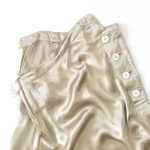Are you ready to learn how to add some stylishly frayed details to your linen fabric? Look no further!
In this article, we will guide you through the process of fraying linen fabric, from selecting the perfect fabric to adding distressed touches.
Get ready to give your linen a unique and trendy look that will make heads turn.
Let’s dive in and discover the art of fraying linen fabric together!
Table of Contents
Selecting the Right Linen Fabric
When selecting the right linen fabric, it’s important to consider the desired fraying effect. Choosing the right type of linen fabric can greatly impact the final look of your project. There are different types of linen fabric available, each with its own unique characteristics.
One type of linen fabric to consider is the plain weave linen. This is the most common type of linen fabric and it is known for its durability and strength. It has a tight weave, which makes it less prone to fraying. If you want a more subtle fraying effect, the plain weave linen is a good choice.
Another option is the herringbone linen fabric. This type of linen has a distinct herringbone pattern, which adds a touch of elegance to any project. The herringbone linen has a slightly looser weave compared to the plain weave linen, making it more prone to fraying. If you want a more pronounced fraying effect, the herringbone linen is a great choice.
Lastly, you can also consider the linen blend fabric. This type of fabric is a mix of linen and other fibers, such as cotton or polyester. The linen blend fabric offers a wide range of options in terms of fraying effects. Depending on the blend ratio, you can achieve different levels of fraying.
Preparing the Linen Fabric for Fraying
Before you begin preparing the linen fabric for fraying, make sure to wash and dry it thoroughly. This is an important step to remove any dirt, oils, or chemicals that may be present on the fabric. Once the fabric is clean and dry, you can proceed with preparing it for fraying.
First, determine the desired length and width of your frayed linen fabric. Use a ruler or measuring tape to accurately measure and mark the fabric. Next, use sharp fabric scissors to cut along the marked lines. Be careful to cut straight and even lines to ensure a clean and uniform frayed edge.
After cutting the fabric, you can use various hemming techniques to prevent further fraying. One option is to fold the edge of the fabric over by about half an inch and then sew a straight stitch along the folded edge. Another option is to use a serger or overlock machine to finish the edges of the fabric. This will create a neat and professional look.
There are different types of linen fabric available, such as plain weave, twill weave, and herringbone weave. Each type has its own unique characteristics and fraying potential. It’s important to consider the type of linen fabric you are working with and adjust your fraying technique accordingly.
Fraying Techniques for Linen Fabric
To achieve the desired frayed look on your linen fabric, you can try using a sandpaper or pumice stone to gently distress the edges. This will give your fabric a beautifully worn and textured appearance.
Here are some fraying techniques for different types of fabric:
-
Pull and tear: For a more organic and uneven frayed look, simply pull at the edges of the fabric and tear it slightly. This method works best for lightweight and loosely woven linen fabrics.
-
Machine wash and dry: If you want a more controlled and uniform frayed look, you can wash and dry your linen fabric multiple times. This will cause the threads to loosen and fray naturally.
-
Fray check: To prevent excessive fraying and unraveling, you can use a product called fray check. Apply it to the edges of your linen fabric to secure the threads and create a clean and controlled frayed look.
-
Embellishments and stitching: Get creative with your frayed linen fabric by incorporating embellishments and stitching. Add buttons, beads, or embroidery to the frayed edges to create unique and personalized home decor pieces.
Adding Distressed Details to Frayed Linen
Enhance the worn and textured appearance of your frayed linen by adding distressed details such as subtle rips and patches. Distressing techniques, commonly used for denim fabric, can also be applied to linen to create a vintage look with frayed edges.
To achieve this distressed effect, start by gently fraying the edges of your linen fabric using a seam ripper or a pair of small scissors. Be careful not to cut too deep or create large holes. The goal is to create a frayed, worn-out look without compromising the fabric’s integrity.
Once you have frayed the edges, you can further enhance the distressed appearance by adding subtle rips and patches. To create rips, use a pair of tweezers to pull out individual threads along the frayed edges. This will create a more natural and worn-out look. For patches, you can use small scraps of fabric in complementary colors and textures. Simply sew or glue them onto the frayed areas, making sure to blend them seamlessly with the rest of the fabric.
Finishing and Caring for Frayed Linen Fabric
After you have created the distressed look, it is important to properly care for your frayed linen to maintain its appearance and longevity. Caring for frayed linen fabric may seem daunting, but with the right techniques, you can ensure that your fabric stays in great condition for years to come. Here are four essential tips for maintaining frayed linen fabric:
-
Gentle Washing: When it comes to cleaning frayed linen, opt for a gentle hand wash or a delicate cycle in the washing machine. Use cold water and a mild detergent specifically designed for delicate fabrics. Avoid using bleach or harsh chemicals that can damage the fibers.
-
Drying: After washing, avoid wringing out the fabric as it can cause further fraying. Instead, gently squeeze out the excess water and lay the fabric flat to dry. Avoid using a dryer, as the heat can weaken the fibers and cause shrinkage.
-
Ironing: If your frayed linen fabric needs ironing, use a low heat setting and place a thin cloth or pressing cloth between the iron and the fabric. This will prevent direct heat from damaging the frayed edges.
-
Storage: When not in use, store your frayed linen fabric in a cool, dry place away from direct sunlight. Avoid folding it too tightly to prevent unnecessary stress on the frayed edges.
Conclusion
To conclude, fraying linen fabric is a simple yet effective way to add a distressed and unique look to your clothing or home decor. By selecting the right linen fabric and properly preparing it for fraying, you can achieve the desired results.
There are various techniques you can use to fray the linen, and you can also add additional distressed details for a more customized look. Remember to finish and care for your frayed linen fabric properly to ensure its longevity.
With these steps, you’ll be able to create stunning frayed linen pieces that stand out.



